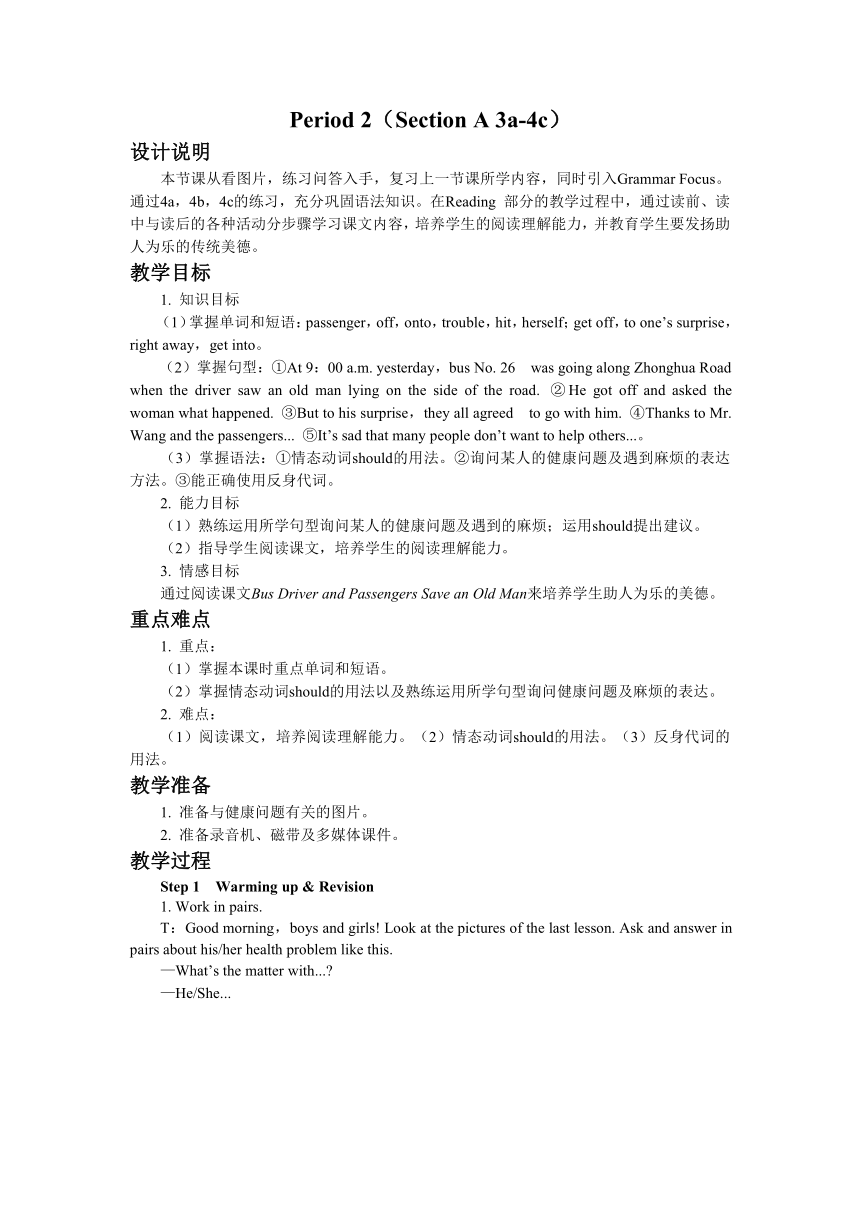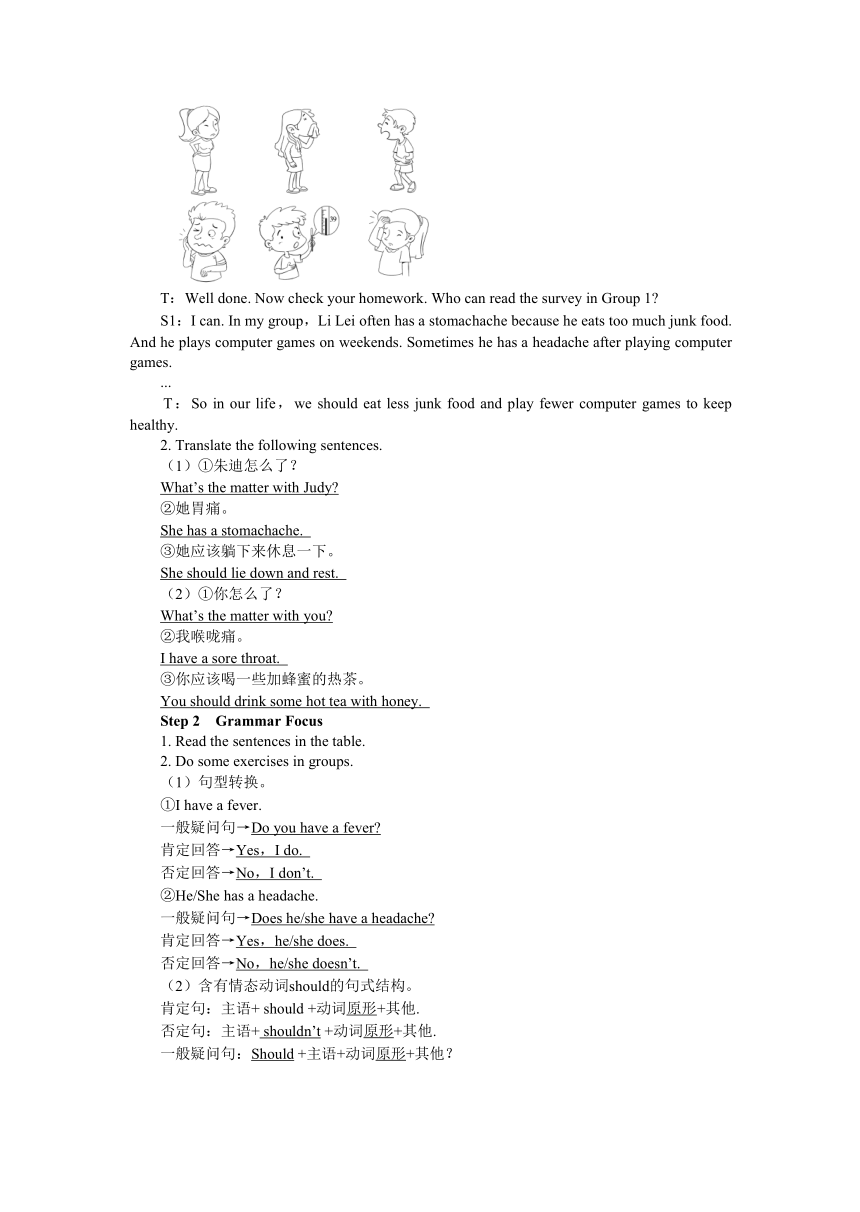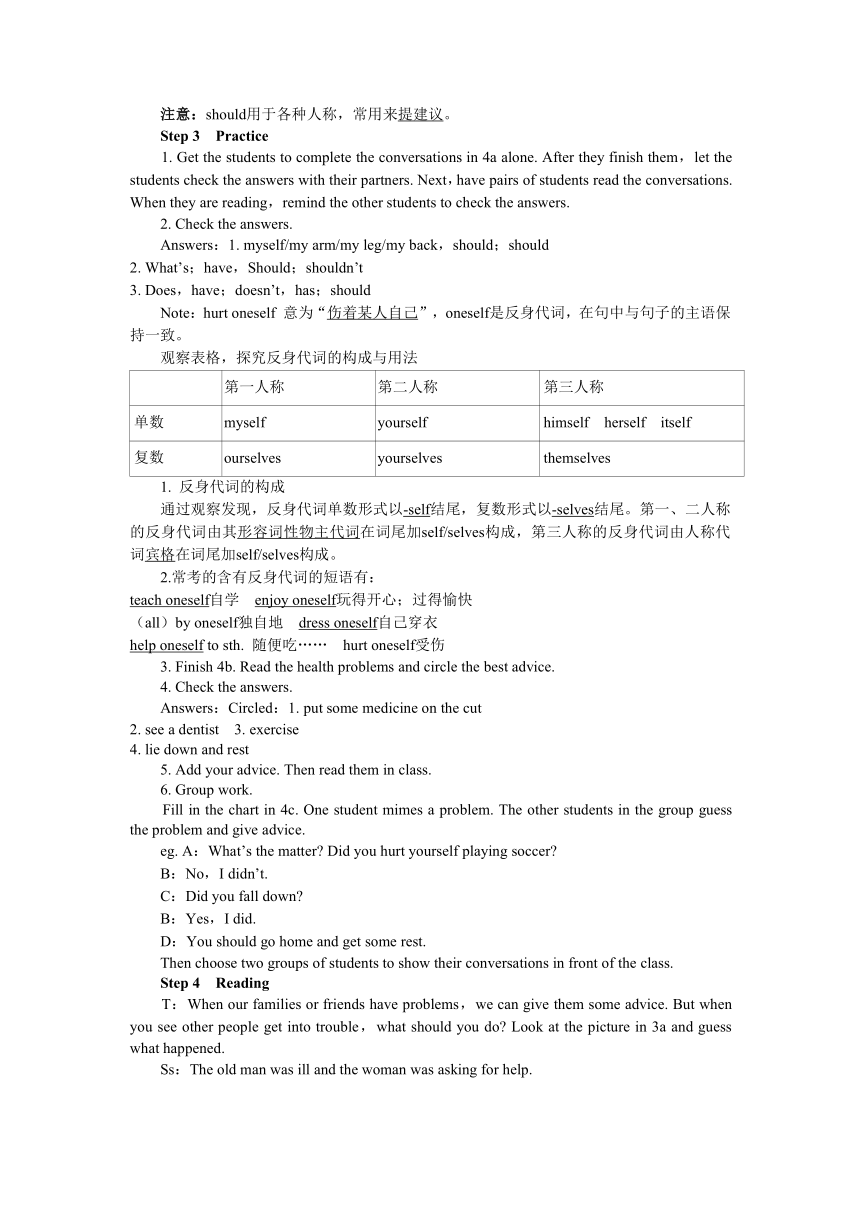UNIT 1 Period 2 (Section A 3a-4c)教学详案
文档属性
| 名称 | UNIT 1 Period 2 (Section A 3a-4c)教学详案 |  | |
| 格式 | docx | ||
| 文件大小 | 491.0KB | ||
| 资源类型 | 试卷 | ||
| 版本资源 | 人教新目标(Go for it)版 | ||
| 科目 | 英语 | ||
| 更新时间 | 2024-02-21 19:33:35 | ||
图片预览



文档简介
Period 2(Section A 3a-4c)
设计说明
本节课从看图片,练习问答入手,复习上一节课所学内容,同时引入Grammar Focus。通过4a,4b,4c的练习,充分巩固语法知识。在Reading 部分的教学过程中,通过读前、读中与读后的各种活动分步骤学习课文内容,培养学生的阅读理解能力,并教育学生要发扬助人为乐的传统美德。
教学目标
1. 知识目标
(1)掌握单词和短语:passenger,off,onto,trouble,hit,herself;get off,to one’s surprise,right away,get into。
(2)掌握句型:①At 9:00 a.m. yesterday,bus No. 26 was going along Zhonghua Road when the driver saw an old man lying on the side of the road. ②He got off and asked the woman what happened. ③But to his surprise,they all agreed to go with him. ④Thanks to Mr. Wang and the passengers... ⑤It’s sad that many people don’t want to help others...。
(3)掌握语法:①情态动词should的用法。②询问某人的健康问题及遇到麻烦的表达方法。③能正确使用反身代词。
2. 能力目标
(1)熟练运用所学句型询问某人的健康问题及遇到的麻烦;运用should提出建议。
(2)指导学生阅读课文,培养学生的阅读理解能力。
3. 情感目标
通过阅读课文Bus Driver and Passengers Save an Old Man来培养学生助人为乐的美德。
重点难点
1. 重点:
(1)掌握本课时重点单词和短语。
(2)掌握情态动词should的用法以及熟练运用所学句型询问健康问题及麻烦的表达。
2. 难点:
(1)阅读课文,培养阅读理解能力。(2)情态动词should的用法。(3)反身代词的用法。
教学准备
1. 准备与健康问题有关的图片。
2. 准备录音机、磁带及多媒体课件。
教学过程
Step 1 Warming up & Revision
1. Work in pairs.
T:Good morning,boys and girls! Look at the pictures of the last lesson. Ask and answer in pairs about his/her health problem like this.
—What’s the matter with...
—He/She...
T:Well done. Now check your homework. Who can read the survey in Group 1
S1:I can. In my group,Li Lei often has a stomachache because he eats too much junk food. And he plays computer games on weekends. Sometimes he has a headache after playing computer games.
...
T:So in our life,we should eat less junk food and play fewer computer games to keep healthy.
2. Translate the following sentences.
(1)①朱迪怎么了?
What’s the matter with Judy
②她胃痛。
She has a stomachache.
③她应该躺下来休息一下。
She should lie down and rest.
(2)①你怎么了?
What’s the matter with you
②我喉咙痛。
I have a sore throat.
③你应该喝一些加蜂蜜的热茶。
You should drink some hot tea with honey.
Step 2 Grammar Focus
1. Read the sentences in the table.
2. Do some exercises in groups.
(1)句型转换。
①I have a fever.
一般疑问句→Do you have a fever
肯定回答→Yes,I do.
否定回答→No,I don’t.
②He/She has a headache.
一般疑问句→Does he/she have a headache
肯定回答→Yes,he/she does.
否定回答→No,he/she doesn’t.
(2)含有情态动词should的句式结构。
肯定句:主语+ should +动词原形+其他.
否定句:主语+ shouldn’t +动词原形+其他.
一般疑问句:Should +主语+动词原形+其他?
注意:should用于各种人称,常用来提建议。
Step 3 Practice
1. Get the students to complete the conversations in 4a alone. After they finish them,let the students check the answers with their partners. Next,have pairs of students read the conversations. When they are reading,remind the other students to check the answers.
2. Check the answers.
Answers:1. myself/my arm/my leg/my back,should;should
2. What’s;have,Should;shouldn’t
3. Does,have;doesn’t,has;should
Note:hurt oneself 意为“伤着某人自己”,oneself是反身代词,在句中与句子的主语保持一致。
观察表格,探究反身代词的构成与用法
第一人称 第二人称 第三人称
单数 myself yourself himself herself itself
复数 ourselves yourselves themselves
1. 反身代词的构成
通过观察发现,反身代词单数形式以-self结尾,复数形式以-selves结尾。第一、二人称的反身代词由其形容词性物主代词在词尾加self/selves构成,第三人称的反身代词由人称代词宾格在词尾加self/selves构成。
2.常考的含有反身代词的短语有:
teach oneself自学 enjoy oneself玩得开心;过得愉快
(all)by oneself独自地 dress oneself自己穿衣
help oneself to sth. 随便吃…… hurt oneself受伤
3. Finish 4b. Read the health problems and circle the best advice.
4. Check the answers.
Answers:Circled:1. put some medicine on the cut
2. see a dentist 3. exercise
4. lie down and rest
5. Add your advice. Then read them in class.
6. Group work.
Fill in the chart in 4c. One student mimes a problem. The other students in the group guess the problem and give advice.
eg. A:What’s the matter Did you hurt yourself playing soccer
B:No,I didn’t.
C:Did you fall down
B:Yes,I did.
D:You should go home and get some rest.
Then choose two groups of students to show their conversations in front of the class.
Step 4 Reading
T:When our families or friends have problems,we can give them some advice. But when you see other people get into trouble,what should you do Look at the picture in 3a and guess what happened.
Ss:The old man was ill and the woman was asking for help.
T:Good. I agree with you. Now let’s read it to know more.
1. Read the passage. Underline and learn the new words and phrases.
2. Read the passage fast and answer the question.
The general idea of this article is about .
A. an accident B. a good deed
C. a sad thing happening on a bus
Answer:B
3. Read the passage again and check(√)the things that happened in the story.Then check the answers.
Answers:1.√ 3.√ 5.√ 6.√
4. Read the passage again and find out what happened according to the time line.
5. Read 3a. Find out the important phrases.
(1)看见某人正躺在路边 see sb. lying on the side of the road
(2)下车 get off
(3)患心脏病 have a heart problem
(4)期望某人做某事 expect sb. to do sth.
(5)等待 wait for
(6)令某人惊讶的是 to one’s surprise
(7)同意做某事 agree to do sth.
(8)幸亏;由于 thanks to
(9)及时 in time
(10)考虑 think about
Step 5 Cooperative inquiry
Give the students important and difficult sentences. Discuss them in groups.
(1)At 9:00 a.m. yesterday,bus No. 26 was going along Zhonghua Road when the driver saw an old man lying on the side of the road.
①这是一个主从复合句,主句是At 9:00 a. m. yester-day,bus No. 26 was going along Zhonghua Road,从句是 when the driver saw an old man lying on the side of the road。
②lying是lie的现在分词形式;see sb. doing sth. 意为“看见某人正在做某事”。
(2)He got off and asked the woman what happened.
get off 的反义短语为get on。
有关get的短语还有:
get up 起床 get along 进展
get down 从……下来 get back 回来
get to到达 get into陷入,参与
get ready for 为……做好准备
(3)But to his surprise,they all agreed to go with him.
①to one’s surprise 意为“令某人惊讶的是”,一般放在句首,one’s也可以是形容词性物主代词。
令我吃惊的是 to my surprise
令汤姆吃惊的是 to Tom’s surprise
②agree to do sth. 意为“同意做某事”。
(4)Thanks to Mr. Wang and the passengers,the man was saved by the doctors in time.
thanks to意为“由于……,多亏……”,其中to为介词,其后可接名词或代词。thanks for意为“为……而感谢”,for后可接名词、代词或动词-ing形式,表示感谢的原因。
Step 6 Discussing and retelling the story
1. Discuss the questions in 3c with a partner.
2. Read the passage aloud.
3. Retell the story.
T:Look at the chart,and retell the story.
When At 9:00 a. m. yesterday
Where On Zhonghua Road
Who The bus driver,24-year-old Wang Ping,many passengers,a woman and an old man.
What Beginning (开端) The driver saw an old man lying on the side of the road. A woman next to him was shouting for help.
Development (发展) Wang Ping stopped the bus without thinking twice. From the woman,he knew that the man had a heart problem and should go to the hospital. So he expected most or all of the passengers to get off and wait for the next bus.
Climax (高潮) But to his surprise,all the passengers agreed to go with him. Some passengers helped Mr. Wang to move the man onto the bus.
Ending (结局) Thanks to Wang Ping and the passengers,the man was saved by the doctors in time.
Evaluation(评价) A passenger says,“The driver didn’t think about himself. He only thought about saving a life. ”
Step 7 Summary
T:In this lesson we have learned a story and“Grammar Focus”. First,the story. What did you learn from the story
Ss:...
T:Next,the“Grammar Focus”.
Who Problems Advice
I stomachache not eat too much
my brother toothache see a dentist
Jim’s friend sore throat drink hot tea with honey
Tina’s sister fever drink lots of water
Model:I have a stomachache. I should not eat too much.
当堂达标(见导学案“当堂达标”)
答案与解析:
Ⅰ. 1. surprise to our surprise意为“令我们惊讶的是”。
2. passengers 句意为“公共汽车上挤满了乘客”。passenger名词,意为“乘客”,由句意可知此处应用其复数形式,故填passengers。
3. agreed 句意为“最后,我们同意去云南度假”。agree动词,意为“同意”,由at last可知此处应用agree的过去式agreed。
4. trouble 句意为“当你在学校有麻烦时,你可以向老师寻求帮助”。trouble名词,意为“麻烦”。
5. get off get off意为“下车”。句意为“直到公共汽车停下才能下车”。
Ⅱ. 1. hit 由yesterday morning知应用一般过去时,故填hit的过去式,hit的过去式与原形拼写相同。
2. yourself hurt oneself意为“伤着某人自己”,由Lucy为单数知应填you的反身代词yourself。
3. thinking without为介词,后接动词-ing形式,故填thinking。
4. go 情态动词should后接动词原形,故填go。
Ⅲ. 1. A expect sb. to do sth. 意为“期望某人做某事”。
2. B thanks to 意为“幸亏,由于”;thanks for意为“因……而感谢”。由句意“多亏了那些乘客,医生才及时挽救了那名男子的生命”可知选B。
3. A agree to do sth. 意为“同意做某事”。
4. C see sb. doing sth. 意为“看见某人正在做某事”,强调动作正在进行;see sb. do sth. 意为“看见某人做某事”,强调动作发生的整个过程。由句意“当我路过公园时,我看见一些老年人正在打中国太极拳”知C项符合题意。
5. D 在英语中,当听到不好的事情发生时,常说“I’m sorry to hear that.”以示礼貌。由上句句意“我妈妈生病了”可知,下句表示“听到这我很难过”,故 选D。
Ⅳ. 1. What’s the matter with 对病情提问用“What’s the matter with sb. ”,意为“某人怎么了?”。
2. shouldn’t drink any 含有情态动词should的句子变否定句时在should后加not,否定句中some一般改为any。
3. Does,have 句中谓语动词为has,变一般疑问句 时应借助助动词does,其结构为:Does +主语+ have + ...
4. When did,start 对“一段时间+ ago”提问用疑问词when,when放在句首,后接一般疑问句;由句中谓语动词started可知该句为一般过去时,when后应加did,started改为原形start。
5. What should,do 由画线部分可知此处提问“她应该做什么?”,故该句式为:What should she do
Ⅴ. 1. To our surprise 2. think;twice
3. right away/at once 4. Thanks to 5. get into trouble
Ⅵ. 1. doctor 由下文walked into the doctor’s office可知 “老妇人是去看医生”,doctor意为“医生”;前面有不定冠词a,故填单数形式doctor。
2. matter What’s the matter with... 意为“……怎么了?”,是询问病情的固定句型。故填matter。
3. hurt hurt意为“疼”;由上下文知填hurt的过去式hurt。
4. feeling feeling名词,意为“感觉”,前面有不定冠词a,故填feeling。
5. temperature 6. nothing 7. health 8. trouble
9. illness illness意为“疾病”,为不可数名词。
10. same
Step 8 Homework
1. Read and copy the new words of this lesson.
2. Read the story“Bus Driver and Passengers Save an Old Man”and try to retell it.
板书设计
UNIT 1 What’s the matter Period 2(Section A 3a-4c)
passenger off onto trouble hit herself get off to one’s surprise right away get into thanks to think about 1. ...when... 2. ...asked...what happened. 3. Thanks to... 4. It’s...that...
教学反思
设计说明
本节课从看图片,练习问答入手,复习上一节课所学内容,同时引入Grammar Focus。通过4a,4b,4c的练习,充分巩固语法知识。在Reading 部分的教学过程中,通过读前、读中与读后的各种活动分步骤学习课文内容,培养学生的阅读理解能力,并教育学生要发扬助人为乐的传统美德。
教学目标
1. 知识目标
(1)掌握单词和短语:passenger,off,onto,trouble,hit,herself;get off,to one’s surprise,right away,get into。
(2)掌握句型:①At 9:00 a.m. yesterday,bus No. 26 was going along Zhonghua Road when the driver saw an old man lying on the side of the road. ②He got off and asked the woman what happened. ③But to his surprise,they all agreed to go with him. ④Thanks to Mr. Wang and the passengers... ⑤It’s sad that many people don’t want to help others...。
(3)掌握语法:①情态动词should的用法。②询问某人的健康问题及遇到麻烦的表达方法。③能正确使用反身代词。
2. 能力目标
(1)熟练运用所学句型询问某人的健康问题及遇到的麻烦;运用should提出建议。
(2)指导学生阅读课文,培养学生的阅读理解能力。
3. 情感目标
通过阅读课文Bus Driver and Passengers Save an Old Man来培养学生助人为乐的美德。
重点难点
1. 重点:
(1)掌握本课时重点单词和短语。
(2)掌握情态动词should的用法以及熟练运用所学句型询问健康问题及麻烦的表达。
2. 难点:
(1)阅读课文,培养阅读理解能力。(2)情态动词should的用法。(3)反身代词的用法。
教学准备
1. 准备与健康问题有关的图片。
2. 准备录音机、磁带及多媒体课件。
教学过程
Step 1 Warming up & Revision
1. Work in pairs.
T:Good morning,boys and girls! Look at the pictures of the last lesson. Ask and answer in pairs about his/her health problem like this.
—What’s the matter with...
—He/She...
T:Well done. Now check your homework. Who can read the survey in Group 1
S1:I can. In my group,Li Lei often has a stomachache because he eats too much junk food. And he plays computer games on weekends. Sometimes he has a headache after playing computer games.
...
T:So in our life,we should eat less junk food and play fewer computer games to keep healthy.
2. Translate the following sentences.
(1)①朱迪怎么了?
What’s the matter with Judy
②她胃痛。
She has a stomachache.
③她应该躺下来休息一下。
She should lie down and rest.
(2)①你怎么了?
What’s the matter with you
②我喉咙痛。
I have a sore throat.
③你应该喝一些加蜂蜜的热茶。
You should drink some hot tea with honey.
Step 2 Grammar Focus
1. Read the sentences in the table.
2. Do some exercises in groups.
(1)句型转换。
①I have a fever.
一般疑问句→Do you have a fever
肯定回答→Yes,I do.
否定回答→No,I don’t.
②He/She has a headache.
一般疑问句→Does he/she have a headache
肯定回答→Yes,he/she does.
否定回答→No,he/she doesn’t.
(2)含有情态动词should的句式结构。
肯定句:主语+ should +动词原形+其他.
否定句:主语+ shouldn’t +动词原形+其他.
一般疑问句:Should +主语+动词原形+其他?
注意:should用于各种人称,常用来提建议。
Step 3 Practice
1. Get the students to complete the conversations in 4a alone. After they finish them,let the students check the answers with their partners. Next,have pairs of students read the conversations. When they are reading,remind the other students to check the answers.
2. Check the answers.
Answers:1. myself/my arm/my leg/my back,should;should
2. What’s;have,Should;shouldn’t
3. Does,have;doesn’t,has;should
Note:hurt oneself 意为“伤着某人自己”,oneself是反身代词,在句中与句子的主语保持一致。
观察表格,探究反身代词的构成与用法
第一人称 第二人称 第三人称
单数 myself yourself himself herself itself
复数 ourselves yourselves themselves
1. 反身代词的构成
通过观察发现,反身代词单数形式以-self结尾,复数形式以-selves结尾。第一、二人称的反身代词由其形容词性物主代词在词尾加self/selves构成,第三人称的反身代词由人称代词宾格在词尾加self/selves构成。
2.常考的含有反身代词的短语有:
teach oneself自学 enjoy oneself玩得开心;过得愉快
(all)by oneself独自地 dress oneself自己穿衣
help oneself to sth. 随便吃…… hurt oneself受伤
3. Finish 4b. Read the health problems and circle the best advice.
4. Check the answers.
Answers:Circled:1. put some medicine on the cut
2. see a dentist 3. exercise
4. lie down and rest
5. Add your advice. Then read them in class.
6. Group work.
Fill in the chart in 4c. One student mimes a problem. The other students in the group guess the problem and give advice.
eg. A:What’s the matter Did you hurt yourself playing soccer
B:No,I didn’t.
C:Did you fall down
B:Yes,I did.
D:You should go home and get some rest.
Then choose two groups of students to show their conversations in front of the class.
Step 4 Reading
T:When our families or friends have problems,we can give them some advice. But when you see other people get into trouble,what should you do Look at the picture in 3a and guess what happened.
Ss:The old man was ill and the woman was asking for help.
T:Good. I agree with you. Now let’s read it to know more.
1. Read the passage. Underline and learn the new words and phrases.
2. Read the passage fast and answer the question.
The general idea of this article is about .
A. an accident B. a good deed
C. a sad thing happening on a bus
Answer:B
3. Read the passage again and check(√)the things that happened in the story.Then check the answers.
Answers:1.√ 3.√ 5.√ 6.√
4. Read the passage again and find out what happened according to the time line.
5. Read 3a. Find out the important phrases.
(1)看见某人正躺在路边 see sb. lying on the side of the road
(2)下车 get off
(3)患心脏病 have a heart problem
(4)期望某人做某事 expect sb. to do sth.
(5)等待 wait for
(6)令某人惊讶的是 to one’s surprise
(7)同意做某事 agree to do sth.
(8)幸亏;由于 thanks to
(9)及时 in time
(10)考虑 think about
Step 5 Cooperative inquiry
Give the students important and difficult sentences. Discuss them in groups.
(1)At 9:00 a.m. yesterday,bus No. 26 was going along Zhonghua Road when the driver saw an old man lying on the side of the road.
①这是一个主从复合句,主句是At 9:00 a. m. yester-day,bus No. 26 was going along Zhonghua Road,从句是 when the driver saw an old man lying on the side of the road。
②lying是lie的现在分词形式;see sb. doing sth. 意为“看见某人正在做某事”。
(2)He got off and asked the woman what happened.
get off 的反义短语为get on。
有关get的短语还有:
get up 起床 get along 进展
get down 从……下来 get back 回来
get to到达 get into陷入,参与
get ready for 为……做好准备
(3)But to his surprise,they all agreed to go with him.
①to one’s surprise 意为“令某人惊讶的是”,一般放在句首,one’s也可以是形容词性物主代词。
令我吃惊的是 to my surprise
令汤姆吃惊的是 to Tom’s surprise
②agree to do sth. 意为“同意做某事”。
(4)Thanks to Mr. Wang and the passengers,the man was saved by the doctors in time.
thanks to意为“由于……,多亏……”,其中to为介词,其后可接名词或代词。thanks for意为“为……而感谢”,for后可接名词、代词或动词-ing形式,表示感谢的原因。
Step 6 Discussing and retelling the story
1. Discuss the questions in 3c with a partner.
2. Read the passage aloud.
3. Retell the story.
T:Look at the chart,and retell the story.
When At 9:00 a. m. yesterday
Where On Zhonghua Road
Who The bus driver,24-year-old Wang Ping,many passengers,a woman and an old man.
What Beginning (开端) The driver saw an old man lying on the side of the road. A woman next to him was shouting for help.
Development (发展) Wang Ping stopped the bus without thinking twice. From the woman,he knew that the man had a heart problem and should go to the hospital. So he expected most or all of the passengers to get off and wait for the next bus.
Climax (高潮) But to his surprise,all the passengers agreed to go with him. Some passengers helped Mr. Wang to move the man onto the bus.
Ending (结局) Thanks to Wang Ping and the passengers,the man was saved by the doctors in time.
Evaluation(评价) A passenger says,“The driver didn’t think about himself. He only thought about saving a life. ”
Step 7 Summary
T:In this lesson we have learned a story and“Grammar Focus”. First,the story. What did you learn from the story
Ss:...
T:Next,the“Grammar Focus”.
Who Problems Advice
I stomachache not eat too much
my brother toothache see a dentist
Jim’s friend sore throat drink hot tea with honey
Tina’s sister fever drink lots of water
Model:I have a stomachache. I should not eat too much.
当堂达标(见导学案“当堂达标”)
答案与解析:
Ⅰ. 1. surprise to our surprise意为“令我们惊讶的是”。
2. passengers 句意为“公共汽车上挤满了乘客”。passenger名词,意为“乘客”,由句意可知此处应用其复数形式,故填passengers。
3. agreed 句意为“最后,我们同意去云南度假”。agree动词,意为“同意”,由at last可知此处应用agree的过去式agreed。
4. trouble 句意为“当你在学校有麻烦时,你可以向老师寻求帮助”。trouble名词,意为“麻烦”。
5. get off get off意为“下车”。句意为“直到公共汽车停下才能下车”。
Ⅱ. 1. hit 由yesterday morning知应用一般过去时,故填hit的过去式,hit的过去式与原形拼写相同。
2. yourself hurt oneself意为“伤着某人自己”,由Lucy为单数知应填you的反身代词yourself。
3. thinking without为介词,后接动词-ing形式,故填thinking。
4. go 情态动词should后接动词原形,故填go。
Ⅲ. 1. A expect sb. to do sth. 意为“期望某人做某事”。
2. B thanks to 意为“幸亏,由于”;thanks for意为“因……而感谢”。由句意“多亏了那些乘客,医生才及时挽救了那名男子的生命”可知选B。
3. A agree to do sth. 意为“同意做某事”。
4. C see sb. doing sth. 意为“看见某人正在做某事”,强调动作正在进行;see sb. do sth. 意为“看见某人做某事”,强调动作发生的整个过程。由句意“当我路过公园时,我看见一些老年人正在打中国太极拳”知C项符合题意。
5. D 在英语中,当听到不好的事情发生时,常说“I’m sorry to hear that.”以示礼貌。由上句句意“我妈妈生病了”可知,下句表示“听到这我很难过”,故 选D。
Ⅳ. 1. What’s the matter with 对病情提问用“What’s the matter with sb. ”,意为“某人怎么了?”。
2. shouldn’t drink any 含有情态动词should的句子变否定句时在should后加not,否定句中some一般改为any。
3. Does,have 句中谓语动词为has,变一般疑问句 时应借助助动词does,其结构为:Does +主语+ have + ...
4. When did,start 对“一段时间+ ago”提问用疑问词when,when放在句首,后接一般疑问句;由句中谓语动词started可知该句为一般过去时,when后应加did,started改为原形start。
5. What should,do 由画线部分可知此处提问“她应该做什么?”,故该句式为:What should she do
Ⅴ. 1. To our surprise 2. think;twice
3. right away/at once 4. Thanks to 5. get into trouble
Ⅵ. 1. doctor 由下文walked into the doctor’s office可知 “老妇人是去看医生”,doctor意为“医生”;前面有不定冠词a,故填单数形式doctor。
2. matter What’s the matter with... 意为“……怎么了?”,是询问病情的固定句型。故填matter。
3. hurt hurt意为“疼”;由上下文知填hurt的过去式hurt。
4. feeling feeling名词,意为“感觉”,前面有不定冠词a,故填feeling。
5. temperature 6. nothing 7. health 8. trouble
9. illness illness意为“疾病”,为不可数名词。
10. same
Step 8 Homework
1. Read and copy the new words of this lesson.
2. Read the story“Bus Driver and Passengers Save an Old Man”and try to retell it.
板书设计
UNIT 1 What’s the matter Period 2(Section A 3a-4c)
passenger off onto trouble hit herself get off to one’s surprise right away get into thanks to think about 1. ...when... 2. ...asked...what happened. 3. Thanks to... 4. It’s...that...
教学反思
同课章节目录
- Unit 1 What's the matter?
- Section A
- Section B
- Unit 2 I'll help to clean up the city parks.
- Section A
- Section B
- Unit 3 Could you please clean your room?
- Section A
- Section B
- Unit 4 Why don't you talk to your parents?
- Section A
- Section B
- Unit 5 What were you doing when the rainstorm came
- Section A
- Section B
- Review of Units 1-5
- Unit 6 An old man tried to move the mountains.
- Section A
- Section B
- Unit 7 What's the highest mountain in the world?
- Section A
- Section B
- Unit 8 Have you read Treasure Island yet?
- Section A
- Section B
- Unit 9 Have you ever been to a museum?
- Section A
- Section B
- Unit 10 I've had this bike for three years.
- Section A
- Section B
